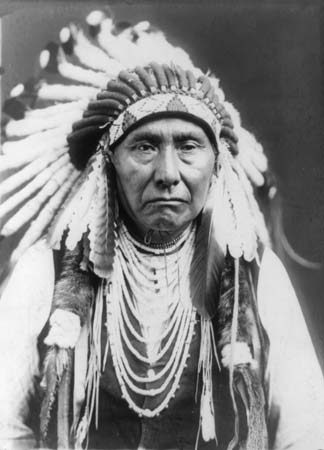Chief Joseph (Chief Joseph)

Hin-mah-too-yah-lat-kekt, Hinmatóowyalahtq̓it in Americanist orthography, popularly known as Chief Joseph or Young Joseph (March 3, 1840 – September 21, 1904), succeeded his father Tuekakas (Chief Joseph the Elder) as the leader of the Wal-lam-wat-kain (Wallowa) band of Nez Perce, a Native American tribe indigenous to the Wallowa Valley in northeastern Oregon, in the interior Pacific Northwest region of the United States. Chief Joseph led his band during the most tumultuous period in their contemporary history when they were forcibly removed from their ancestral lands in the Wallowa Valley by the United States federal government and forced to move northeast, onto the significantly reduced reservation in Lapwai, Idaho Territory. A series of events that culminated in episodes of violence led those Nez Perce who resisted removal, including Joseph’s band and an allied band of the Palouse tribe, to take flight to attempt to reach political asylum, ultimately with the Lakota led by Sitting Bull, who had sought refuge in Canada. They were pursued eastward by the U.S. Army in a campaign led by General Oliver O. Howard. This 1,170-mile (1,900 km) fighting retreat by the Nez Perce in 1877 became known as the Nez Perce War. The skill with which the Nez Perce fought and the manner in which they conducted themselves in the face of incredible adversity led to widespread admiration among their military adversaries and the American public.
Coverage of the war in United States newspapers led to widespread recognition of Chief Joseph and the Nez Perce. For his principled resistance to the removal, he became renowned as a humanitarian and peacemaker. However, modern scholars, like Robert McCoy and Thomas Guthrie, argue that this coverage, as well as Joseph’s speeches and writings, distorted the true nature of Joseph’s thoughts and gave rise to a “mythical” Chief Joseph as a “red Napoleon” that served the interests of the Anglo-American narrative of manifest destiny. An indomitable voice of conscience for the West, in September 1904, still in exile from his homeland, he died – according to his doctor – “of a broken heart”. Meany and Curtis helped Joseph’s family bury their chief near the village of Nespelem. Chief Joseph is buried in Nespelem, Washington, where many of his tribe’s members still live.
Born
- March, 03, 1840
- USA
- Wallowa Valley, Oregon
Died
- September, 21, 1904
- USA
- Colville Indian Reservation, Washington,
Cause of Death
- natural causes
Cemetery
- Nez Perce Cemetery
- Nespelem, Washington
- USA


